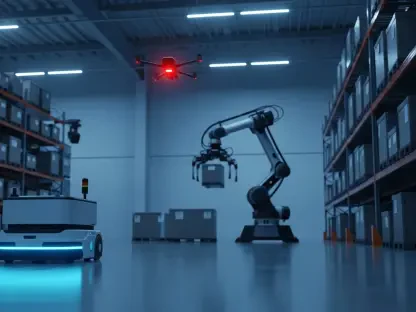Imagine a fleet of drones delivering packages across a bustling city, only to be hijacked mid-flight by malicious hackers, crashing into buildings or disappearing with valuable cargo, a scenario that is no longer a distant threat but a pressing reality. As drones become ubiquitous in commercial and industrial applications across the U.S., their rapid integration into sectors like e-commerce, infrastructure inspection, and agriculture has caused the risk of cyberattacks to skyrocket, posing significant safety and economic challenges. Enter the Drone Cybersecurity Shield, or SHIELD, a pioneering defensive system developed by researchers at Florida International University (FIU). This technology promises to safeguard drones from digital threats in real time, potentially revolutionizing how aerial operations are secured.
Understanding the Rising Threat Landscape
Drones have transformed industries by enabling faster deliveries, detailed inspections, and efficient crop monitoring, but their reliance on wireless communication and complex control systems makes them prime targets for cyber interference. Hackers can exploit vulnerabilities to redirect drones, disable their functions, or cause catastrophic failures, endangering lives and disrupting operations. The Federal Aviation Administration (FAA) continues to push for expanded drone usage, amplifying the urgency for robust protective measures to ensure these devices operate without interference.
The need for advanced cybersecurity in this domain cannot be overstated. Traditional security approaches often fall short, focusing narrowly on specific data points while ignoring broader system dynamics. As a result, many existing frameworks resort to terminating missions at the first sign of trouble, sacrificing efficiency for safety. This gap in drone defense has paved the way for innovative solutions like SHIELD to address the evolving nature of cyber risks.
Key Innovations of the SHIELD System
Comprehensive Real-Time Monitoring
Unlike conventional methods that solely analyze sensor data, SHIELD takes a holistic approach by scrutinizing the entire control system of a drone. Developed under the leadership of Associate Professor Mohammad Ashiqur Rahman at FIU, this technology detects anomalies across hardware and software components, such as unexpected battery surges or overheating processors, which could signal a cyberattack. This broad monitoring capability ensures early identification of threats, minimizing the window for potential damage.
Such an all-encompassing strategy sets SHIELD apart from other systems that might overlook subtle but critical warning signs. By continuously assessing the health of every operational aspect, it provides a layered defense mechanism. This proactive stance is crucial for maintaining drone integrity during high-stakes missions where even minor disruptions can have significant consequences.
Machine Learning-Driven Threat Response
At the heart of SHIELD’s effectiveness lies its use of machine learning to pinpoint specific types of cyberattacks through unique attack signatures. Once a threat is identified, the system activates tailored recovery protocols to neutralize it and restore normal functionality. This ability to adapt responses based on the nature of the attack marks a significant leap forward in drone security technology.
What makes this feature particularly groundbreaking is its focus on mission continuity. While many current defenses default to shutting down operations when under attack, SHIELD strives to keep the drone operational, ensuring that critical tasks are not abruptly halted. Lab simulations have demonstrated impressive results, with attacks detected in just 0.21 seconds and flight operations restored in a mere 0.36 seconds, underscoring its potential for practical deployment.
Industry Implications and Practical Applications
The integration of SHIELD into real-world scenarios could transform industries reliant on drone technology. In e-commerce, where timely deliveries are paramount, this system could prevent costly interruptions caused by cyber intrusions. Similarly, in infrastructure monitoring, SHIELD ensures that drones inspecting bridges or power lines remain operational, safeguarding vital data collection processes against malicious interference.
Beyond commerce, the technology holds promise for disaster response, where drones often play a critical role in assessing damage or delivering aid. Ensuring their security in such high-pressure environments is essential for effective outcomes. Rahman emphasizes that reliable drones are foundational to future advancements, suggesting that SHIELD could be a cornerstone for expanding aerial capabilities in these fields.
The alignment with FAA proposals to broaden drone applications further highlights the timeliness of this innovation. As regulatory frameworks evolve to accommodate more complex operations, having a robust cybersecurity solution like SHIELD becomes indispensable for maintaining public trust and operational safety across diverse sectors.
Current Challenges and Barriers to Adoption
Despite its potential, SHIELD faces several hurdles in transitioning from controlled lab environments to widespread real-world use. Technical challenges include scaling the system to handle the unpredictable variables of live operations, where environmental factors and diverse drone models could impact performance. Addressing these inconsistencies remains a priority for the FIU team as they refine the technology.
Regulatory constraints also pose a significant obstacle, as compliance with aviation and cybersecurity standards must be ensured before broad implementation. Market adoption presents another challenge, with industries potentially hesitant to invest in new systems without extensive field testing. Overcoming these barriers will require strategic partnerships and rigorous validation to build confidence in SHIELD’s capabilities.
Ongoing development efforts are focused on mitigating these limitations, with plans to enhance system adaptability and streamline integration processes. The commitment to addressing these issues suggests a path toward eventual widespread acceptance, provided that testing phases yield consistent and reliable results in dynamic settings.
Looking Ahead: The Future of Drone Defense
As cyber threats grow in sophistication, SHIELD stands poised to play a pivotal role in shaping the future of drone security. Plans for extensive real-world testing over the next few years, starting from 2025, aim to validate its effectiveness under actual operational conditions. These trials will be critical in identifying areas for improvement and ensuring the system can handle the complexities of diverse environments.
Potential breakthroughs in enhancing efficiency, such as optimizing machine learning algorithms for faster response times, could further solidify SHIELD’s position as a leader in this space. Additionally, collaboration with industry stakeholders and regulatory bodies will be essential to align the technology with emerging standards and needs. The long-term impact could redefine safety and reliability benchmarks for drone operations globally.
The evolution of this technology also opens the door to broader innovations in autonomous systems beyond drones. By establishing a model for real-time threat detection and recovery, SHIELD could inspire similar advancements in other fields reliant on unmanned technology, amplifying its influence on cybersecurity as a whole.
Final Thoughts on SHIELD’s Journey
Reflecting on the evaluation, SHIELD proved to be a remarkable step forward in tackling the cybersecurity challenges that plague drone operations. Its ability to detect threats swiftly and enable mission recovery distinguishes it from conventional defenses that often prioritize shutdowns over continuity. The lab results speak volumes about its potential, even as real-world application remains a work in progress.
Moving forward, the focus should shift to accelerating field testing and forging alliances with industry leaders to facilitate seamless adoption. Stakeholders need to prioritize funding and resources to support the transition from simulation to practical deployment. Addressing regulatory and scalability concerns head-on will be vital to ensure that this technology reaches its full potential.
Ultimately, the path ahead demands a collaborative effort to refine and promote SHIELD as a standard for drone security. Exploring integration with emerging technologies and adapting to new threat landscapes should be the next steps, ensuring that drones remain a trusted tool for innovation across industries.









